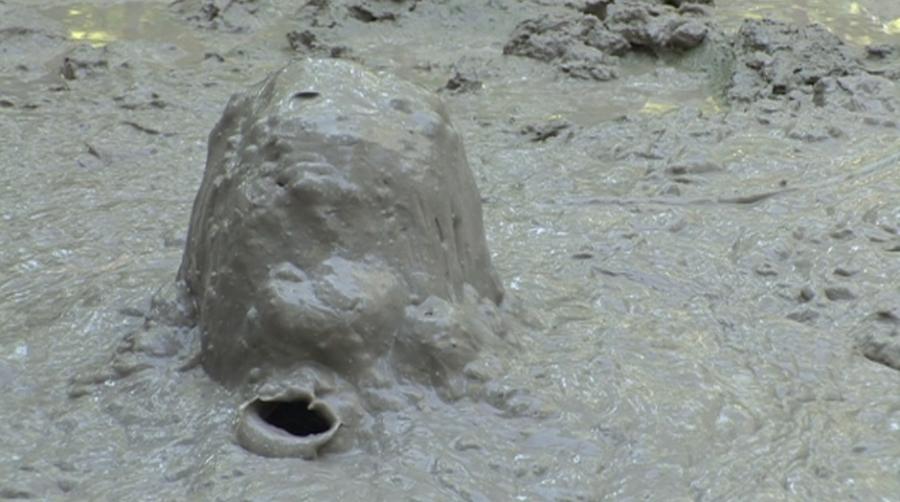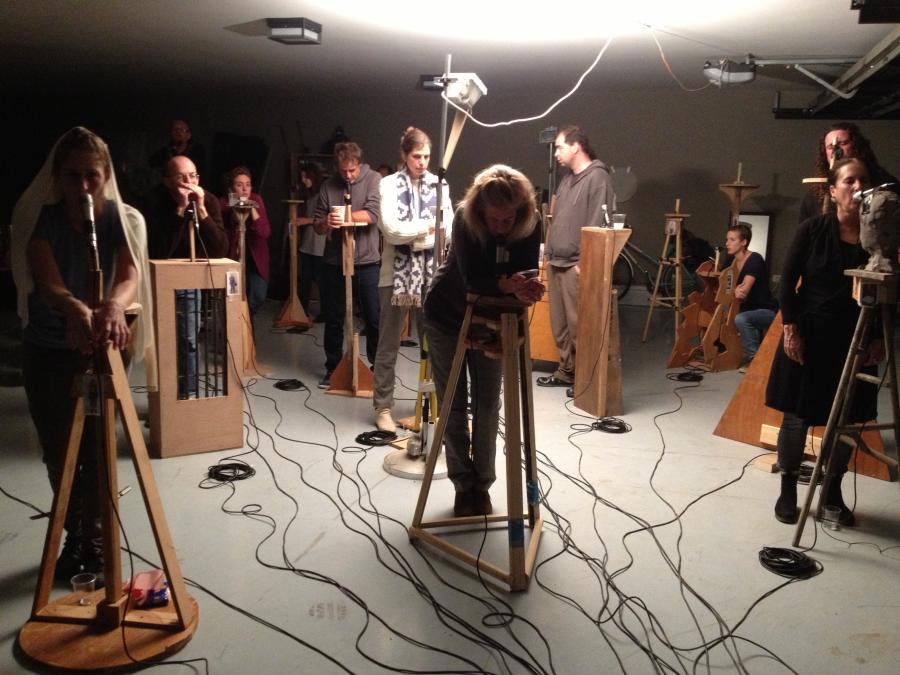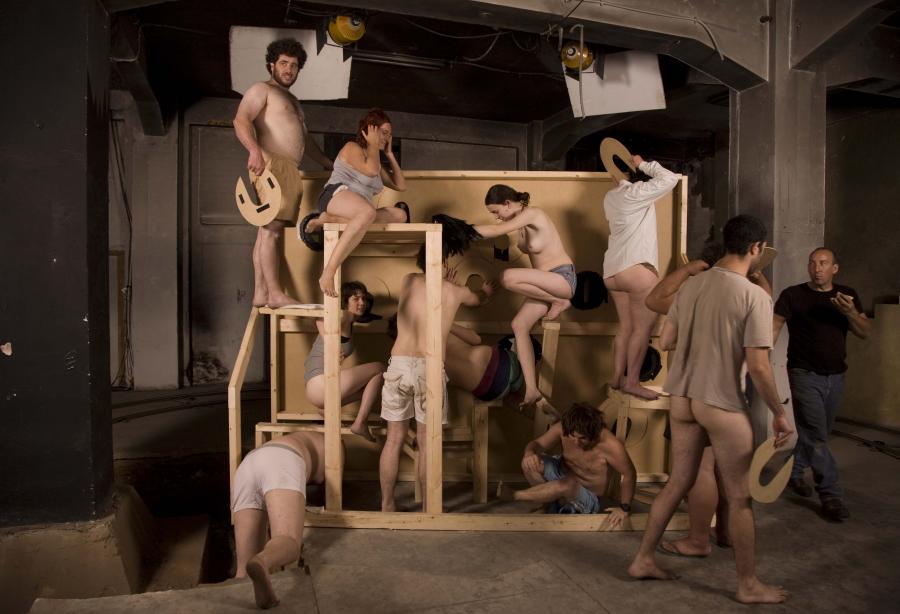The relationship between things
Mira Hirtz talks to Gilad Ratman
To see the full contribution, including pictures and links
added by Gilad Ratman, please download the PDF.
Print (A4, centered, one-sided) and fold before consumption.
I became familiar with Gilad Ratman’s work through the exhibition of The 588 project (2009) and Multipillory (2010) at the gallery Ferenbalm-Gurbrü Station in Karlsruhe 2011, and in the Israeli pavilion at the Venice Biennial 2013, where his project The Workshop was realized. I was intrigued by his tactile use of materiality, the concomitant absurd atmosphere of ungraspability and his compositions of actual natural and technical objects, screenings, sounds, as well as performers. The synthesis of these various elements create messy, yet detailed organisms and apparatuses. Within these, things do not serve as a means to capture reality. Still, they remind us that life is not just fiction. To me, Gilad Ratman’s work is dealing with stories, quivering between reality and fiction, an activity that the things initiate, and yet remain about the things themselves. On Wednesday, the 17th of June, he starts our skype conversation with:
GR:
A few years ago I would almost have said that I am a structuralist. Today I say, that in large, I am more interested in the relationship (MH;1) between things than things themselves.
(MH;1: Does this mean that I was wrong and that this is not fitting into the frame of not the frame, but the things? Of course this would be put too simply, as the title of this issue #two is meant provocatively. It gives a tendency, yet its naive assumption about the clear outline of what a frame is and what a thing is wishes to open up the question about what we comprehend as an object.)
GR:
The object is usually referred to as the thing itself. But that is just the upper level. If you go deeper, and that’s one of the things which speculative realism offered us, and before that Bruno Latour and Deleuze, you can ask: What is material? It is a network, a relationship between particles. When I use for example mud, I’m not seeing it as something monolithic and closed, but I always try to look at materials from many perspectives. Always in context to some other things. And mainly through its function and its potential. When I use mud, I use it because I think it is caught between solid and liquid. It can function as a skin and as a territory at the same time. Meaning, if a head comes out of the mud, the latter is elastic enough to cover the head and to be part of it, like our skin is.
Gilad Ratman: 588 Project, 2009, 08:00 min, video still
When I look at material I look at its functionality, the reference we can attach to it and the way it is structured on the atom level. Speculation and potential are very important in the role of defining what an object is. This is also a trajectory to the performative (MH;2), but lets suspend it for a while.
(MH;2: Within the conversation we never made it back to the performative. Nevertheless, the performative as a cluster of physical and cultural actions, the effects of which cannot be subsumed to a logical structure is very relevant here. It allows one to look at the tension that is at work when we try to separate frames and things.)
GR:
There is a pendulum between what seems to be an object and what seems to be a structure. What seems to be the thing and what seems to be the relationship between things. But this tension is embedded in every level of understanding. If you put an artwork in a gallery, then there is the relationship between the artwork and the gallery, the relationship of the gallery to the street, the street to the people and the gallery, there is always a system created. It never stops. And it’s also in the very core of the material itself.
MH:
In your work, do you want the spectator to enter into the process (MH;3) of trying to create a meaning but breaking it again and again?
(MH;3: We talked about Heidegger. According to Heidegger, the artwork describes the constant struggle between its materiality and the world it opens up. A struggle that never ends in harmony, as the opened world, meaning or interpretation, is always closured back by the material.)
GR:
Completely. You can impose meaning but then the artwork or the material is bouncing back at you, talks to you or claims something, says ‹I can be something else› or ‹Are you sure that this is it?› By that it becomes clear that meaning is never stable. So in my work I’m not only trying to manifest this in the experience of the viewer but also within my process. I always feel that if I understand what it means, I am not doing it. I need the work of art to give me troubles. It is important to me that there are many ways to enter an artwork. It’s about tunnels of meaning. Does material hold meaning by itself? I don’t know. But at least I can say that art, as a phenomena does not exist in the world at all. There is no such a thing. Everything is equally in the world. Art exists only in perception. There is not even one object that is art by itself. This is, I think, what speculative realism is kind of ignoring while trying to talk about art. Yes, it is a great feeling, and even useful to say ‹Not everything is language. Yes, there is a real thing.› But if we talk about art we are in the realm of perception. And the realm of perception is a realm of relationships.
MH:
Would you say that there is a certain way of combining and assemblaging (MH;4), in a Deleuzian manner, objects, so that there is a certain kind of aesthetic perception that leads to art?
(MH;4: Deleuze talks about the realm of the social as one that is not built from atoms leveling up to concrete material, but from complex configurations of materials and practices that are assemblages of other complex configurations. I wonder if one can, within these assemblages, clearly oppose the real thing and its perception. And if one can categorize certain assemblages’ qualities.)
GR:
Yes, and this is the potential of art: to create something from material that is suggesting to us to generate meaning in a way that will oppose, or add, or subvert, or change our immediate connections with materials and objects. And it will – if the artwork is good – always be in conflict. By perception I mean on the first level the scientific definitions. Our brain is distinguishing things, even if there are no borders in the world. The other levels would be our connotations, culture. All these realms are not in the object itself.
MH:
You are actually playing a lot with connotations within your artworks. For me there is an archaic atmosphere: using mud, clay to shape the head – and not a computer –, primitive-like creatures. On a first sight this seemed romantic to me. But then there is also something funny and absurd. So: why do you choose these certain materials?
GR:
I often relate to basic materials. Why? I guess I often drive to things that are raw. But for my newest piece I cannot commit to that, as I am using styrofoam and drones. I find materials interesting according to their ability to change form or function. This goes for the clay, but also for the sound. Sound, I cannot understand what it is. I work with raw material as much as with waves of light or sound. To mix them together, to know that they are very different from each other, is also happening in the primarily medium I use, which is video. Sound and clay are similar to me. Both can wear any form. As in The Workshop, when the clay is still wet, and when I took the sounds of the performers turning them into techno music or tribal – in the digital area, once it becomes ‹1 and 0›, everything could be everything. I like that sound and clay are behaving in a similar way. In The Workshop, the performers are caught between these two things and in a way alsochange (MH;5).
Gilad Ratman: The Workshop, 2013, videostill
(MH;5: Having seen the exhibition, to me, ‹being caught› occurred as the attempt to articulate. Feeling the instability of meaning and reality, the only act one can perform is the constant effort of articulating and thereby shaping the concrete material. But, in this productive manner of moving things, you may be moved as-well.)
MH:
How much control do you have over the material? Is the opposite relation – the material forming you – also having an impact?
GR:
Yes, first of all I do think it is a dual relationship, and the material is forming you in a different way than you are forming the material. It is not a symmetric relationship. Actually, to say what is changing the material is easier than to say what is changing you. Of course, when we now speak about change, it is complicated: what do we mean by the term changing? Maybe there is only something changing in our perception. Maybe everything is a primordial ooze of mud and we are just shifting things. But for us, we do distinguish between a hefad and a shoe. And if I do something that is a cross between a head and a shoe, maybe that’s when art starts to happen. Because then, in front of this, you have to relocate yourself. Art for me is very much about relocating in a territory that is familiar and unfamiliar at the same time. You realize that the box of tools that you have does not fit. This is the first encounter that I like about art, which can be described in very easy words that would be: ‹What the fuck›. The sense of ‹what the fuck› is very important. A good work of art is one that encourages you to invent new tools.
MH:
For the artist and the audience.
GR:
Yes. It’s always a tension between the familiar and the unfamiliar. It’s like: Coming back drunk after a party to your home, opening the door and there are people sitting that you don’t know, playing cards. Then you’d have to readjust. A good work of art throws you out and takes you back in, like a constant pendulum. It has to resist you.
MH:
I had this experience in The Workshop: It is a story that you were sucked into, but also spatially, it wasn’t explaining everything and was playing a trick on me. The layer of playing tricks was one part, but the other really important part to me was that the heads made out of clay were ‘really’ present in the room, just as the sounds were really audible and affecting me. I think that I needed the ‘things’ to create the pendulum irritation that you described, otherwise it would have been all concept and not had an impact on me.
GR:
For me the term would be manipulation. I try to stretch and manipulate structures, materials, habits, cultures, whatever I can. To some degree, to the point of the instability. I believe that trough manipulation we can understand more. I’m more interested in what can become of something, through manipulation, than in some fidelity or loyalty to an event or material. Maybe it has to do with the ‹drifting- truth situation›, my generation was born into. Having said that, the experience itself (of the creation or the one of the viewer) is dear to me. I’m kind of Herzogian in that sense. Werner Herzog emphasized many times that the physical labor on the set, especially carrying and moving heavy objects, is essential to the experience of making something. I feel the same about that. You called it romantic before. Yes, there is a kind of romanticism about the urge to experience something – going to Romania with five heavy metal bands, or going to Arkansas to sink in mud, or sticking my friends into a pillory in which they cannot move – most of the time it‘s about physical experience. But finally, in screening, we end up with light on the wall. There is nothing there. Everything that is on view, screened, becomes the same phenomena: Photons running form the projector. That’s why screening is different from having an actual sculpture in the space: Screening is unified, so flat. it has no weight, no thickness and no surface.
MH:
And then, sometimes, you add the dimension of human heads sticking through something flat.
Gilad Ratman: Multipillory, 2010, installation shot
GR:
In the beginning, explaining the ‹reciprocal turn›, you said that art is often referring to another piece of art or culture. I agree, but some of my works relate to themselves. For example, in The Workshop, the work is related to the space you are in. It is like a Möbius ring or solipsistic circle, in which you, as the viewer, see something that also happened before in this space. This invites you to think about the gap of time and gap of space that occurs, it creates a sense of history and disappearance and connects you to the event: The time of ‹now› is charged with a lot of things that happened before. That’s a self-referential history. In Multipillory, you go behind the structure and realize that there is the same structure functioning. The Workshop was an extension of that. Now, in my new work with the drones, I installed it in a way that I want you to think about the space projected as a model of the actual space.
MH:
OK. Thank you for now! My head is full. I will work on the interview and sent it to you and we can see, how to go on with your contribution to this Journal.
GR:
I think it would be good to start with the text. And I have a suggestion: I will try to attach to the text different notes that I am thinking about, that are related to it. Could be many things. To throw us into many directions. To show that we cannot have a true trajectory.
MH:
Which would relate very much to what we started with: the relationships and network.
Gilad Ratman was born in Haifa, Israel, in 1975, and studied at the Bezalel Academy for Art and Design (BFA), Jerusalem, and Columbia University (MFA), New York. Solo exhibitions have included Trafo, Polad (2015); the Israel Museum, Jerusalem (2015); MACBA - Museum of Contemporary Art, Buenos Aires, Argentina (2014); Israeli Pavilion Venice Biennale, Venice (2013); Museum of Contemporary Art, Chicago (2011); Ferenbalm-Gurb Station, Karlsruhe (2011); Braverman Gallery, Tel Aviv (2010); and the Haifa Museum of Art (2009). Group exhibitions have included Bass Museum of Art, Miami (2012); Herzliya Contemporary Art Biennial, Herzliya (2011); Institute of Contemporary Art, Philadelphia (2011); The Garage Center of Contemporary Art, Moscow (2010); Rencontres d’Arles, Arles, (2010); MoMA PS1, New York (2010); and the Dallas Contemporary Art Center (2010). Ratman has been awarded the Anslem Kiefer Prize by the Wolf Foundation (2011); Art Matters Grant (2010); Jerome Foundation (2010); The Ministry of Culture “Young Artist” Prize (2007) and the Givon Prize of Tel Aviv Museum (2005). Upcomoing exhibitions include Contour 7 Biennial, Mechelen, Curated by Nicola Setari.
